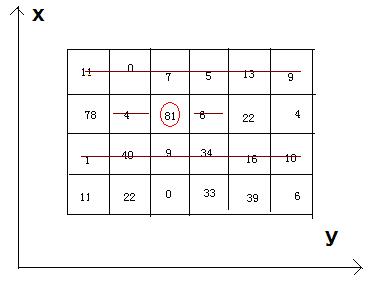Beans
Time Limit: 2000/1000 MS (Java/Others) Memory Limit: 32768/32768 K (Java/Others) Total Submission(s): 4141 Accepted Submission(s): 1964
Problem Description
Bean-eating is an interesting game, everyone owns an M*N matrix, which is filled with different qualities beans. Meantime, there is only one bean in any 1*1 grid. Now you want to eat the beans and collect the qualities, but everyone must obey by the following rules: if you eat the bean at the coordinate(x, y), you can’t eat the beans anyway at the coordinates listed (if exiting): (x, y-1), (x, y+1), and the both rows whose abscissas are x-1 and x+1.

Input
There are a few cases. In each case, there are two integer M (row number) and N (column number). The next M lines each contain N integers, representing the qualities of the beans. We can make sure that the quality of bean isn't beyond 1000, and 1<=M*N<=200000.
Output
For each case, you just output the MAX qualities you can eat and then get.
Sample Input
4 6
11 0 7 5 13 9
78 4 81 6 22 4
1 40 9 34 16 10
11 22 0 33 39 6
Sample Output
242
题解:一次对行dp,一次对列dp;
java超时了。。。c就不会
代码:
import java.util.Scanner; public class Beans { static int a[] = new int[200010], dp[] = new int[200010], DP[] = new int[200010], b[] = new int[200010]; public static void main(String[] argvs){ int M, N; Scanner cin = new Scanner(System.in); while(cin.hasNext()){ M = cin.nextInt(); N = cin.nextInt(); for(int i = 0; i < M; i++){ DP[i] = 0; for(int j = 0; j < N; j++){ dp[j] = 0; a[j] = cin.nextInt(); if(j < 2) dp[j] = a[j]; else dp[j] = Math.max(dp[j - 2] + a[j], dp[j - 1]); } DP[i] = dp[N - 1]; if(i < 2) b[i] = DP[i]; else b[i] = Math.max(b[i - 2] + DP[i], b[i - 1]); } System.out.println(b[M - 1]); } } }